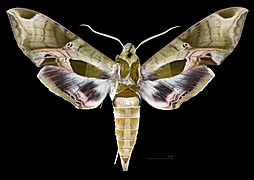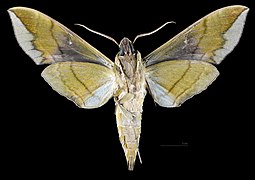Eumorpha pandorus
| Eumorpha pandorus | |
|---|---|

| |
| Scientific classification | |
| Domain: | Eukaryota |
| Kingdom: | Animalia |
| Phylum: | Arthropoda |
| Class: | Insecta |
| Order: | Lepidoptera |
| Family: | Sphingidae |
| Genus: | Eumorpha |
| Species: | E. pandorus
|
| Binomial name | |
| Eumorpha pandorus (Hübner, 1821)
| |
| Synonyms[1]: 111 | |
| |
Eumorpha pandorus, the Pandora sphinx moth or Pandorus sphinx moth, is a North American moth in the family Sphingidae. The species was first described by Jacob Hübner in 1821.
Description
The pandora sphinx moth has a wingspan of 3.25–4.6 inches (8.3–11.7 cm).[2][3] Its wings are opaque and have a greenish-olive background on the dorsal surfaces.[4] The wings are narrow[4] and are held deltaform at rest. Females generally have a larger abdomen than males. There are green markings on the dorsal forewing[4] with a two-toned double spot extending from the base along the forewing's inner margin.[5] When the wings are folded, the latter spot aligns with a dark mark on the moth's body that covers each tegula.[6] A green marking with a pale outline is visible near the apex of the forewing.[6] The dorsal surfaces of the hindwings, when extended, reveal black patches[4] on a white background that becomes greenish-olive near the termens.[6] Pink is present around the torni of the hindwings and in isolated areas on the dorsal forewings.[5] Small dark eyespots on the hindwings and the forewings, there found in the discal position bearing two tiny "pupils," are visible even when the wings are folded.[2][5] The ventral surfaces of the wings are a pale shade of yellow-green or brown.[6]
E. pandorus shares the southern part of its range with E. intermedia.[7] It is distinguished from the latter species by the shape of the darker portion of its basal two-toned spot on the end that faces the forewing's outer margin: it is strongly wing-shaped in E. intermedia due to the shorter length of the spot's inferior border in comparison to its superior border, whereas the spot is more rectangular overall in E. pandorus.[7] In addition, the faint subterminal line on the forewing (located just basal to the apical spot) is typically scalloped in E. intermedia but is straight or slightly sinusoidal in E. pandorus.[7]
Caterpillars grow up to 9 centimetres (3.5 in) and are green in the first instar, but may be one of a variety of colors in later instars, including green or brownish-red.[7][8] The head and first two thoracic segments can be retracted into the third segment.[8] The abdomen has a small spot on the second segment and big white oval spots overlying the last five spiracles.[8] They also have the characteristic "horn" of the Sphingidae hornworms with its base on an eyespot at the end of their abdomen, although only the raised eyespot is present in the last larval instar.[8]
-
Male dorsal
-
Male ventral
-
Female dorsal
-
Female ventral
-
Caterpillar
-
In Durham
Distribution
The species is widespread in the east, the southeast and the center of North America, from Nova Scotia and Ontario to Florida and eastern Texas. It is not present in Mexico or the
Biology
Adult moths fly at dusk.
References
- ^ a b Messenger, Charlie (1997). "The Sphinx Moths (Lepidoptera: Sphingidae) of Nebraska" (PDF). Transactions of the Nebraska Academy of Sciences. 24: 89–141. Retrieved 5 August 2022.
- ^ a b c "Pandorus Sphinx". Fishers Island Conservancy. 17 August 2017. Retrieved 4 August 2022.
- ISBN 978-1-60938-305-3.
- ^ a b c d e f g Beutenmüller, William (February 1903). "The Hawk-Moths of the Vicinity of New York City". Supplement to American Museum Journal. 3 (2). Guide Leaflet No. 10. Retrieved 4 August 2022.
- ^ a b c Covell, Charles (13 August 2020). Cotinis (ed.). "Identification, Adult, Species Eumorpha pandorus". BugGuide. Retrieved 4 August 2022.
- ^ a b c d e Valo, John, ed. (22 July 2022). "Pandorus Sphinx". Minnesotaseasons.com. Retrieved 4 August 2022.
- ^ a b c d e f Montagna, Teá; Montagna, Dan; Kloiber, Stephen (2022). "Eumorpha pandorus". Sphingidae of the United States of America. Retrieved 5 August 2022.
- ^ a b c d Wagner, David; Giles, Valerie (13 August 2020). Cotinis (ed.). "Identification, Larva, Species Eumorpha pandorus". BugGuide. Retrieved 4 August 2022.
- ^ Schweitzer, Dale F. (1 July 2022). "Eumorpha pandorus". NatureServe Network Biodiversity Location Data accessed through NatureServe Explorer. Arlington, Virginia: NatureServe. Retrieved 4 August 2022.
- ^ a b c BugLady (25 January 2011). "Pandorus Sphinx (Family Sphingidae)". College of Letters & Science Field Station. University of Wisconsin-Milwaukee. Retrieved 5 August 2022.
- ^ Moul, Bob (4 September 2006). "Pandorus Sphinx Moth". PBase. Retrieved 5 August 2022.
- . 6543.
External links
- Cotinis (October 7, 2017). "Species Eumorpha pandorus - Pandora Sphinx - Hodges#7859". BugGuide. Retrieved December 10, 2018.






